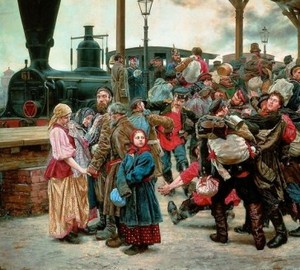
Description of the picture:
To the war – Konstantin Apollonovich Savitsky. 1888. Oil on canvas. 207.5×303.5
The dramatic events of peasant life, the desire to create large epic paintings, and the emotional tension of the scenes feature Savitsky’s work, masters of complex multi-figure compositions. An important role in the realistic orientation of his art was played by his acquaintance with I. N. Kramsky, who became an ideological mentor and friend of Savitsky, which took place back in his studies at the Academy of Arts.
Soon after the formation of the Association of Traveling Art Exhibitions, Savitsky declared himself one of its most active members. Largely continuing the accusatory line of the “sixties”, Savitsky at the same time sought to create positive peasant images. This important tendency in the development of the art of critical realism of the 70s – 80s was reflected in the film “For War”. The idea of the picture was inspired by the impressions associated with the Russian-Turkish war of 1877-1878. The artist worked on this huge canvas for almost ten years. The first version of the picture, which came to us in fragments, was completed in 1880, but he did not satisfy the master. Over the next eight years, Savitsky worked on the second version of the picture presented here.
The war scenes typical of the war years are interpreted as a people’s grief. The artist first of all sought to convey the mood of hopelessness, to show the feelings of the soldiers and their loved ones escorting them in a minute of separation before sending a military train. Savitsky is building the composition, perhaps not without the influence of the painting “Morning of the Archery Execution” by V. I. Surikov.
In the crowd, several groups are distinguished, in each of which the characters’ state of mind is expressed differently. There is no single center in the picture, not a single group dominates, they are all internally interconnected, subordinate to the general idea and only in the aggregate fully reveal it. The artist conveys numerous shades of personal human experiences from the frenzied despair of a woman being separated from her husband to the silent grief of an old woman who has crouched by her son’s chest. The image of this middle-aged, surrounded by family, severe, restraining his feelings of a peasant is distinguished by a convincing psychological characteristic. Among the new recruits, a young soldier is especially distinguished, who, with a bewilderment look, finally turned to his wife, who was tearing it,."